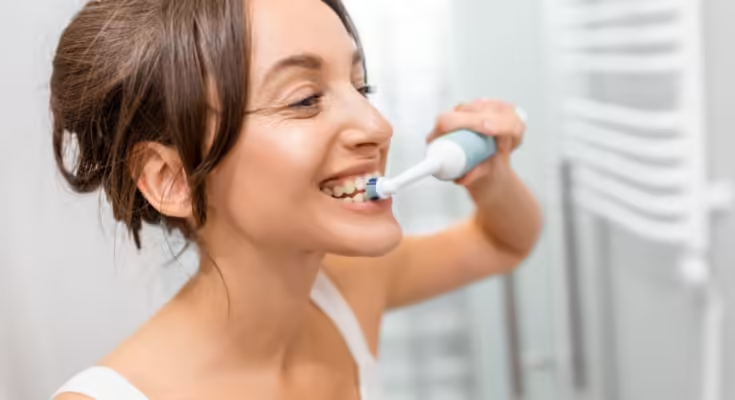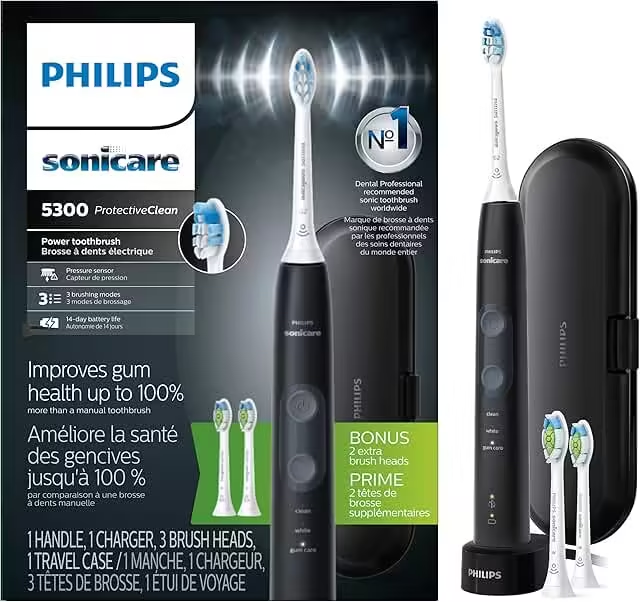Maintaining oral hygiene can be a significant challenge for individuals with Parkinson’s disease due to symptoms like tremors, rigidity, and bradykinesia, which make precise movements difficult. Electric toothbrushes offer a practical solution by providing consistent, automated brushing motions that can help overcome these motor difficulties. These devices not only enhance the effectiveness of brushing but also reduce the physical effort required, making daily dental care more manageable for those living with Parkinson’s. In this blog post, we’ll explore the benefits of electric toothbrushes and how they can improve the quality of life for people with Parkinson’s disease.
Review: Oral-B Electric Toothbrush Line
The Oral-B electric toothbrush line stands out as an excellent option for individuals with Parkinson’s disease, offering a range of features that cater to their unique needs. I have personally used Oral-B brushes because they brush each tooth with ease, and the refill brush heads are affordable. Here are some key aspects that make these toothbrushes particularly beneficial:
1. Consistent Brushing Motion:
Oral-B electric toothbrushes provide a consistent and automated brushing motion, which is crucial for individuals with Parkinson’s who may struggle with hand tremors and rigidity. This ensures thorough cleaning without requiring precise manual control.
2. Ergonomic Design:
The ergonomic handle design of Oral-B toothbrushes makes them easier to grip and maneuver, even for those with limited dexterity. This reduces the strain on the hands and wrists, making the brushing experience more comfortable.
3. Timer and Pressure Sensors:
Many models come equipped with built-in timers and pressure sensors. The timer helps ensure that users brush for the recommended two minutes, while the pressure sensor alerts them if they are brushing too hard, protecting their gums from damage.
4. Customizable Brush Heads:
Oral-B offers a variety of brush heads designed for different needs, including sensitive teeth and gums. This customization allows users to choose the best option for their oral health requirements. As I’ve already mentioned, the brush heads are very affordable to refill when the old one is word out.
5. Long Battery Life:
The long battery life of Oral-B electric toothbrushes means fewer recharges, which is convenient for users who may find frequent charging challenging. This also makes these brushes ideal for short travel (up to week between charges in my own experience).
6. Bluetooth Connectivity:
Some advanced models feature Bluetooth connectivity, allowing users to track their brushing habits via a smartphone app. This can be particularly useful for caregivers who want to monitor the oral hygiene of their loved ones with Parkinson’s.
Overall, the Oral-B electric toothbrush line provides a practical and effective solution for maintaining oral hygiene in individuals with Parkinson’s disease. Its thoughtful design and advanced features help overcome the motor challenges associated with the condition, making daily dental care more manageable and effective.
Review: Sonicare Electric Toothbrush Line
The Sonicare electric toothbrush line by Philips is a highly recommended option for individuals with Parkinson’s disease, offering several features that cater to their specific needs. Before using the Oral-B brushes, I used Sonicare brushes exclusively for about five years. Here are some key benefits:
1. Sonic Technology:
Sonicare toothbrushes use advanced sonic technology to deliver up to 62,000 brush movements per minute. This high-frequency motion ensures thorough cleaning, even in hard-to-reach areas, without requiring precise manual control. Because of the brush head’s oval shape, I wasn’t able to brush each tooth as well as I would have liked, so this made the brushing feel less clean.
2. Gentle on Gums:
These toothbrushes are designed to be gentle on gums and teeth, making them ideal for individuals with sensitive mouths or those prone to gum recession. The gentle yet effective cleaning action helps maintain oral health without causing discomfort.
3. Built-in Timers and Pacing:
Sonicare models come with built-in timers that ensure users brush for the dentist-recommended two minutes. Additionally, a pacer alerts users every 30 seconds to switch areas of the mouth, promoting a comprehensive cleaning routine.
4. Pressure Sensors:
To prevent over-brushing, Sonicare toothbrushes feature pressure sensors that automatically reduce the brush’s intensity if too much pressure is applied. This is particularly beneficial for individuals with Parkinson’s who may have difficulty controlling their brushing force.
5. Customizable Brushing Modes:
Many Sonicare models offer multiple brushing modes, such as Clean, White, and Gum Care. This allows users to customize their brushing experience based on their specific oral health needs.
6. Long Battery Life:
The long-lasting battery life of Sonicare toothbrushes means fewer recharges, which is convenient for users who may find frequent charging challenging. Although I did notice the battery dying more quickly after about a year’s worth of brushing. This could be due to a faulty toothbrush, and a call to customer service helped resolve the problem.
7. Easy-to-Replace Brush Heads:
Sonicare toothbrushes come with easy-to-replace brush heads, and some models even have replacement alerts to remind users when it’s time to change the brush head. This ensures optimal performance and hygiene.
Overall, the Sonicare electric toothbrush line offers a practical and effective solution for maintaining oral hygiene in individuals with Parkinson’s disease. Its advanced features and thoughtful design help overcome the motor challenges associated with the condition, making daily dental care more manageable and effective.
Summary:
- Oral-B is a great choice for those who prefer oscillating-rotating technology and value features like Bluetooth connectivity and a variety of brush heads.
- Sonicare is ideal for those who prefer sonic technology and need a gentle yet effective cleaning action, with the added benefit of customizable brushing modes and easy-to-replace brush heads.
Both lines offer excellent solutions for maintaining oral hygiene in individuals with Parkinson’s disease, helping to overcome motor challenges and making daily dental care more manageable and effective. The choice ultimately depends on personal preferences and specific needs.





